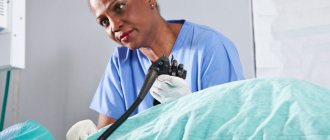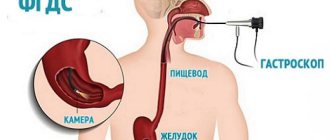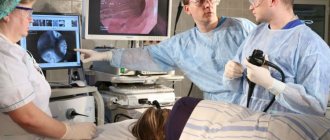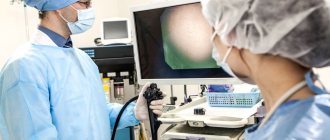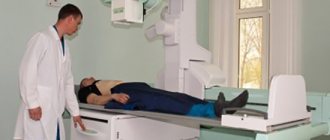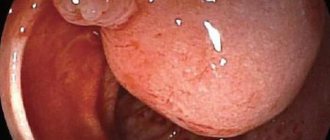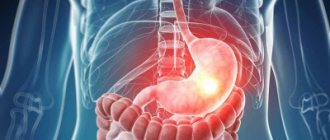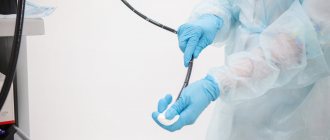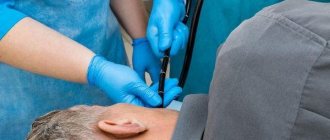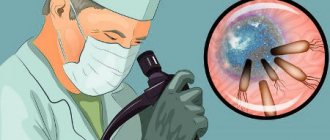In modern medicine, various methods are used to diagnose diseases of the digestive organs. One of them is fibrogastroduodenoscopy. The question: “What kind of procedure is this?” – asks every person who has received a referral for this examination.
FGDS is an informative and very accurate technique for studying the mucous membranes of the digestive tract - the esophagus, the upper part of the duodenum, and the stomach. When performing it, a special optical device is used - an endoscope.
This medical instrument looks like a flexible thin tube (about 1 centimeter in diameter). Inside there is a channel for introducing devices for collecting samples of biological material for analysis, and there are also thin optical fibers that supply lighting and transmit video images.
For many patients, the upcoming procedure causes panic. By their incorrect behavior during the examination, they make this diagnostic and therapeutic manipulation very uncomfortable for themselves. In our article we will tell you when endoscopy is performed and how the patient needs to prepare for the examination in order to easily endure it. We will also give an answer to the question of whether it is painful to do FGDS.
Indications for the procedure
Practicing gastroenterologists recommend diagnosing the organs of the digestive system for preventive purposes, because any pathological process is easier to cure at an early stage of development. The need for examination arises when preparing for abdominal (abdominal) surgery and the following clinical signs appear in the patient:
- frequent abdominal pain of unknown etiology and different nature;
- feelings of heaviness and discomfort in the digestive tract;
- frequent heartburn;
- nausea of unknown origin;
- regular vomiting streaked with blood;
- unpleasant belching;
- dysphagia – problems with swallowing;
- appetite disorders;
- decrease in hemoglobin level in the blood;
- weight loss.
These symptoms are an alarming signal for the development of diseases of the pancreas, liver, and gall bladder.
With the help of FGDS, you can remove foreign bodies from the intestine, remove benign tumors, administer medications, perform a biopsy, perform electrocoagulation, or apply a ligature to a bleeding vessel.
Carrying out fibrogastroscopy (FGS) - examination of the stomach, recommended for suspected peptic ulcers, gastritis, the presence of foreign objects in the organ (coins, buttons, balls), the formation of a benign neoplasm (polyp) or a malignant tumor
Gastroscopy for pregnant women
Many ladies in an interesting position are interested in whether it is dangerous to do gastroscopy and whether it is painful for their child. Doctors agree that such collection of material for analysis is absolutely safe for pregnant women, but it is important to observe the following conditions:
- do not eat 6–7 hours before the procedure;
- carry out analysis only in the 1st–2nd trimester and only after consultation with a gynecologist;
- Be sure to carry out pain relief with lidocaine.
In the case of pregnant women, examination can be carried out only after consultation with a doctor. Without this, the risk of encountering pathologies and unpleasant consequences for the health of mother and baby is very high.
The possibility of sedation, that is, putting you to sleep, is available, but it is important to make sure that there is no allergic reaction to the proposed drugs.
Thanks to gastroscopy, it is possible to make an accurate diagnosis and eliminate problems with the functioning of the gastrointestinal tract. However, many patients are confused by the possible pain of the sensation. Despite the fact that a probe is inserted into the patient’s throat and esophagus, this does not cause any discomfort. With a correctly performed gastroscopy, even a slight burning sensation in the throat disappears after a couple of hours, leaving no traces.
Preparation rules
In many clinics, along with a referral for examination, the patient is always given a brochure that describes in detail the plan of preparatory measures. These recommendations are worth following - it depends on whether the sensations during the procedure will be very painful or not.
On the eve of the FGDS, the patient needs:
Sore throat after FGDS
- do not drink or eat 12 hours before the procedure;
- dinner should consist of foods that are easily digestible and do not irritate the mucous membrane;
- do not eat spicy, pickled and highly salted foods - they cause irritation of the mucous walls of organs, which reduces the accuracy of diagnosis;
- two days before the procedure, exclude chocolate and nuts from the diet - they can linger in the folds of the mucous membranes and complicate the examination;
- do not take medications if necessary - it is better to take the morning medication by injection;
- refrain from smoking - this bad habit contributes to nervousness and involuntary muscle contractions;
- get rid of the feeling of fear, since a negative attitude provokes tension in the muscles of the esophagus - this makes it difficult to insert the endoscopic device;
- know that drooling and belching during the procedure are normal, and medical professionals will conduct the examination as quickly as possible and with minimal discomfort.
Patients are particularly concerned about the biopsy, but this procedure is performed under local anesthesia and there are no consequences after its completion.
Before starting the procedure, the specialist who will carry out the diagnosis will tell the patient in detail about the procedure and possible complications.
FGDS under anesthesia: painless and fast
Is it possible to perform FGDS without pain? Recently, the method of gastroscopy during sleep has been gaining popularity. This is a completely similar study as described above, only in this case the person sleeps and does not feel anything. A person falls asleep under the influence of special anesthetic drugs. This is a kind of anesthesia, only short-term (from 5 to 15 minutes).
The advantage of FGDS under anesthesia is the fact that the person sleeps and does not feel everything that is felt with the traditional research method. Gastroscopy during sleep differs from the traditional method not only in the absence of unpleasant sensations, but also in cost. For comparison: the traditional method will cost 500-1000 rubles, depending on the duration, and gastroscopy in a dream will cost from 3000 to 9000 rubles. Therefore, not everyone, even the most suspicious person, can afford such luxury. With FGDS, a person does not feel anything during sleep, but after waking up, a sore throat occurs, which can last no more than 1 day.
It is important to know! During gastroscopy without anesthesia, a person experiences not only gagging, but also a feeling of shortness of breath. Shortness of breath occurs if the patient does not listen to the doctor and does not follow his instructions.
In conclusion, it should be noted that although the FGDS procedure is an effective research option, it also has its contraindications. Gastroscopy is prohibited for the following diseases:
- inflammatory processes in the mouth and pharynx;
- myocardial infarction;
- disruption of cerebral circulation;
- other types of disorders.
FGDS during pregnancy is permitted only on the recommendation of the attending physician. A timely detected disease is much easier to cure than in an advanced stage.
Breathing during the procedure to reduce pain
In modern medical centers, patients are taught proper breathing techniques several days before FGDS. Knowing the basics of proper breathing will help make the examination minimally unpleasant.
You need to breathe as follows: inhale and exhale through your nose only (if you try to inhale through your mouth, saliva can get into the respiratory tract and cause a cough). Breathing should be slow and deep (short sharp inhalations and exhalations disrupt the process of inserting the probe, which will lead to injury to the esophagus).
A few additional recommendations
As you can see, an appropriate attitude, preliminary preparation and proper breathing help make it easier to endure an FGDS. You can practice breathing on your own, and preparing for the procedure is also not difficult; it’s more difficult to create a positive attitude.
But there are several recommendations:
- Trust in doctors. The confidence that the procedure is being carried out by a good doctor who will try to do everything quickly and painlessly helps you cope with the feeling of fear and relax. Now it is possible to choose a clinic that inspires more confidence, and even a specialist who will perform the procedure.
- Getting rid of false modesty. You should familiarize yourself in advance with what happens during the examination and remember: drooling and belching are normal. Trying to swallow saliva or hold back belching will cause muscle tension and make it difficult to pass the gastroscope.
- The realization that there will be no pain. Many people are afraid that it will hurt, but biopsies, cauterization or other procedures are always performed using local anesthetics, and patients often do not even feel the intervention being performed.
- Taking sedatives. To reduce feelings of fear and panic, you can take motherwort tincture or valerian for several days. In more severe cases, it is possible to prescribe light tranquilizers, but it is better to give preference to herbal preparations.
- Morning mood. You need to prepare in advance that everything will go well, you will only need to endure a few unpleasant, but not very painful moments that will not last long.
But if you can’t get in the mood and calm down, then most clinics may offer to perform a gastroduodenoscopy under general anesthesia. In this case, FGDS will not be felt, but it is always worth considering that anesthesia creates additional stress on the liver. When choosing general anesthesia or undergoing a stomach examination under local anesthesia, you should be guided not only by fear of the upcoming procedure, but also by long-term concern for your health.
It is possible to endure an FGDS easier if you do not strain when discomfort occurs, breathe correctly and prepare yourself for the fact that it will only last a few minutes. If you manage to cope with fear and relax, trusting the doctor, then all unpleasant sensations will become minimal.
How to make the procedure easier
They try to make the procedure as comfortable as possible for the patient. Therefore, he is first given a solution of a local anesthetic to gargle (sometimes they use such products in the form of a spray) to reduce the sensitivity of the pharynx. After just a few minutes, the mucous membranes become numb, after which you can move on to the main part, when the patient needs to hold a special mouthpiece between his teeth - this is necessary to insert the endoscope.
This is where unpleasant sensations may arise associated with the passage of the endoscope from the throat to the esophagus. The patient can facilitate this procedure himself if at this moment he takes a breath and relaxes, and then performs a swallowing movement, during which it will be easier for the doctor to insert the endoscope.
With children the situation is a little different. For children under 6 years of age, this procedure can only be done under general anesthesia. This also applies to people with hypersensitivity.
If FGDS is performed only for diagnosis, then the entire procedure takes no more than 10 minutes. If additional manipulations are performed, all this can take 20-30 minutes. The doctor usually issues a conclusion within an hour. All this time the patient will be under medical supervision. Biopsy results usually come back within a week.
How to decide on FGDS or FCS and not go crazy with fear
You need to undergo an FGDS or FCS, but you just can’t bring yourself to sign up for the procedure, having heard a lot of reviews from friends who “swallowed the hose” and read “horror stories” on the Internet... What will the experts say? Will it hurt during the examination? How long does it last? How is it going? Who should it be shown to? Is there an alternative? These and other questions of concern to many were answered in detail and frankly by Kirill PYATKIN, an endoscopist at the Kivach clinic.
— Let’s first understand the abbreviation: what is FGDS?
— This is fibrogastroduodenoscopy, or gastroscopy, a visual examination using an endoscope of the mucous membrane of the esophagus, stomach, and the initial part of the duodenum.
During the examination, the endoscopist can see various pathological changes - acute and chronic inflammation of the mucous membrane, areas of erosion, ulcers, various gastritis, as well as pathological formations, for example, polyps - local growths of the mucous membrane.
— Is it necessary to “swallow the light bulb”, because now many diseases of internal organs can be detected using, for example, tests, tomography, ultrasound? What are the advantages of endoscopic examination?
- All methods, be it tomography, for example, or fluoroscopy (when the patient drinks a contrast agent, usually barium, and then X-rays are taken) - these methods are in any case mediated by an image or tomogram (layer-by-layer image). If we talk about tumor markers, then this, again, is mediated by analysis.
And the endoscopic examination method gives the doctor the opportunity to look inside the patient. The essence of endoscopy is contained in the name itself: “endo” means “inside”, and “scopy” means “look”. That is, during a gastroscopy, the doctor evaluates everything visually.
Also, during this study, the doctor has the opportunity to take material for a biopsy, if necessary. No other methods have such diagnostic value as visual inspection through an endoscope.
Currently, gastroscopy is the most informative method for assessing the condition of the mucous membrane of the esophagus, stomach and the initial part of the duodenum.
— What symptoms serve as a basis for gastroscopy?
- The most common symptom is heartburn, followed by pain - both when hungry and after eating, a feeling of bloating, a feeling of indigestion of food. That is, any discomfort in the upper abdomen, one way or another associated with food, is an indication for gastroscopy.
— You also conduct FCS at the Kivach clinic. What kind of research is this and who is it for?
— FCS (fibrocolonoscopy) is an endoscopic method for diagnosing the large intestine. There are many indications for colonoscopy. This is a feeling of indigestion or bloating, anemia (decreased hemoglobin), constipation for 3-4 days, as well as heredity (if someone close to you had intestinal tumors, then you need to be checked regularly), cancer screening after 40 years.
— What can be detected during a colonoscopy?
— Congenital elongation of the intestine, a common pathology is elongation of the sigmoid colon, which is manifested mainly by constipation. You can also identify the presence of hemorrhoids and various types of colitis. The main purpose of a colonoscopy is to rule out cancer.
— One of the most important questions that worries everyone who is prescribed FGDS or FCS is whether it hurts?
— Gastroscopy is more unpleasant than painful. And the main reason is the gag reflex, which develops as the endoscope moves through the esophagus.
As for colonoscopy, the main painful moments can occur, firstly, when the endoscope passes the so-called corners of the intestine - there are two of them: splenic and hepatic. The intestine is fixed to the walls of the abdomen, and no matter how flexible the endoscope is, it slightly stretches the intestine from the inside, which can also be painful.
Secondly, during the procedure we inflate the intestines from the inside: we supply carbon dioxide through an endoscope to straighten the intestines and look at all the walls. This is also a certain discomfort for the patient. However, it should be noted that everything is still very individual and depends on the patient’s pain threshold.
Some people lie quietly, as they have no painful sensations, while for others, even the slightest advance of the endoscope already causes pain.
— How can modern medicine cope with this pain?
— At the Kivach clinic we use drug-induced sleep - intravenous sedation. A thin plastic catheter is placed in a vein, which can remain there for a long time, and a drug is administered through it (we use propofol).
While propofol is dosed through a special device, the patient sleeps.
As soon as we have completed the study, the administration of the drug stops, after 5-10 minutes the patient wakes up, and after 20-30 minutes he is already able to get to his feet, change clothes, meet with the doctor and discuss the results of the study.
— What are the advantages of the procedure under sedation?
— Well, firstly, all discomfort, including pain, is relieved. Secondly, if it is necessary to apply some kind of intervention, be it a biopsy or removal of formations, then it is more convenient to do this while the patient is sleeping. Vomiting during gastroscopy is excluded.
Sedation is not the same anesthesia that is used during abdominal operations: here the patient breathes on his own, this is a deep physiological sleep. During the procedure, if necessary, you can even wake up the patient, for example, if you need to ask him to carefully turn on his side.
That is, it is a controlled dream.
However, sedation is contraindicated for those who are allergic to egg white (since propofol is based on it), peanuts and soy.
Naturally, before sedation, cardiac activity, respiratory activity are examined, and tests are taken. This is all assessed together. If there are no contraindications due to concomitant pathology, then there is only one limitation - the above-mentioned allergy.
— How often are gastroscopy and colonoscopy prescribed in pairs: FGDS + FCS?
- Almost always. And at our Kivach clinic, as a rule, they are performed under sedation.
With these two studies, the doctor can look at almost two-thirds of the gastrointestinal tract: the esophagus, stomach, initial part of the duodenum and large intestine.
Only the small intestine remains, but according to statistics, the percentage of some formations, tumors, diseases, etc. The small intestine produces many times less than the stomach and large intestine.
— How long does this general study last?
— If there are no technical difficulties, you don’t need to remove anything, or make any interventions, then the study lasts 30-40 minutes. This is the average data.
— Tell us in more detail, how is everything going?
— Anyone who wants to make an appointment at the Kivach clinic for an examination is sent a questionnaire, which he fills out and sends to the clinic. Doctors, an endoscopist and an anesthesiologist, after studying the questionnaire, assess possible risks and contraindications.
On the day of the examination, the patient comes to the clinic, an endoscopist talks with him, then an anesthesiologist. It is discussed what worries the patient, whether there have been previous examinations, the doctor informs about what and how will happen during the examination, as well as about possible complications.
The patient signs consent to the procedure (the document reflects everything that was discussed), then he goes to the office, changes into special underwear and lies down on the table. The nurse anesthetist places a catheter for sedation for the patient, connects a bunch of sensors to monitor cardiac activity, breathing, and attaches a pulse oximeter to his finger. Then the drug is administered and the patient falls asleep.
The doctor first does a gastroscopy, looking at the upper parts of the gastrointestinal tract. If necessary, he takes tests and a biopsy. When the gastroscopy is completed, the nurse takes the gastroscope to the washing machine in a special machine. Then a colonoscope is connected and a colonoscopy is performed. In the same way, if something needs to be taken or removed, the doctor does it. When we finished, we took the colonoscope for processing. All.
Next comes the patient’s awakening. When the patient has regained consciousness, the results of the study are discussed with the doctor.
— Do I need to prepare in advance somehow?
— Before gastroscopy, you need a 6-8 hour fasting period. As a rule, we try to schedule this test in the morning, that is, it is enough not to have breakfast or drink water in the morning.
Colonoscopy requires preparation - special medications that have a laxative effect and cleanse the intestines. This is mainly fortrans or picoprep. We always give you a diagram of how to take them. We also give you the recommended diet.
That is, gastroscopy means hunger. Colonoscopy requires certain medications plus a special diet. Before sedation, fluids and food are strictly limited to prevent aspiration—the penetration of gastric contents into the airways.
— Are there any contraindications to these endoscopic studies?
— Contraindications are life-threatening conditions: heart attacks, strokes. As a rule, everything is clarified at the examination stage before the procedure. A limitation to the procedure is the use of anticoagulants (blood thinning drugs); in this case, research can be carried out, but any manipulation of the mucous membrane cannot be done.
— Does the patient feel discomfort after the procedure?
— Yes, there is sometimes discomfort, especially after a colonoscopy. This may be a feeling of bloating, a feeling of cramping in the abdomen. But at the Kivach clinic we use carbon dioxide rather than air to inflate the intestines. Firstly, it is absorbed from the intestines into the bloodstream 16 times faster than air, and secondly, it has a certain relaxing effect on the intestinal muscles.
— Based on your practice, can you say what patients are most afraid of?
— Diagnosis: tumors. And anesthesia.
— What do you usually tell your patients before starting a study? How do you configure them?
— Our dialogue usually develops constructively, based on trust. We will calm those who are afraid. For those who have never done this procedure, we will tell you how everything goes, we will show you the tools and equipment. If necessary, I will show a video recording, naturally, impersonal, of what exactly we see inside, what we can do. It is necessary to interest the patient, then the fear goes away immediately.
Source: https://gubdaily.ru/blog/sociology/interview/kak-reshitsya-na-fgds-ili-fks-i-ne-sojti-s-uma-ot-straxa/
Fgds hurts or not
For many patients, the upcoming procedure causes panic.
By their incorrect behavior during the examination, they make this diagnostic and therapeutic manipulation very uncomfortable for themselves.
In our article we will tell you when endoscopy is performed and how the patient needs to prepare for the examination in order to easily endure it. We will also give an answer to the question of whether it is painful to do FGDS.
When to do the test
The FGDS procedure is one of the most effective research methods in the field of gastroenterology. The need to undergo the procedure arises in case of the following indications:
- if you suspect a stomach or intestinal ulcer;
- if esophagitis is suspected;
- if there are suspicions of neoplasms in the digestive organs.
In case of frequent, constant or periodic complaints of stomach pain, as well as nausea, sour belching and defecation disorders, the doctor also prescribes the patient to undergo a gastrointestinal tract examination. But in addition to the study, drug treatment can also be carried out using gastroscopy. This treatment involves detecting and then stopping bleeding when an ulcer opens.
But that’s not all, because with the help of FGDS you can remove various foreign bodies from the gastrointestinal tract that have been eaten.
Most patients are simply afraid to undergo this examination, especially when they learn the details and features of its implementation. It’s normal to be afraid to undergo an FGDS, especially since the procedure is really not the most pleasant.
Only in order to promptly diagnose or eliminate serious diseases, you will need to decide on gastroscopy.
Is it painful to do FGDS?
Examination of the upper digestive tract can cause a lot of discomfort. A considerable proportion of patients who have personally experienced the sensations during gastroscopy assure that it does not hurt. At the same time, they note that FGDS is easier to tolerate if the doctor uses sedation or general anesthesia.
Good to know! Gastroenterologists prefer to use radical methods of pain relief only in extreme cases, when it is assumed that the patient will not be able to adequately tolerate the manipulations.
Discomfort during the procedure is caused by the gastroscope hose, which creates pressure on the root of the tongue. A certain amount of discomfort is caused by the air that the doctor supplies when advancing the tube of the device for better visualization. It can stretch the esophagus and stomach quite strongly, resulting in mild to moderate pain.
For patients who are especially worried about whether gastroscopy is painful or not, a preliminary explanatory conversation is held. In addition, the doctor has the right to conduct a number of tests aimed at establishing the boundaries of the pain threshold. If it is reduced, gastroscopy will be performed without pain under sedation or anesthesia.
Research procedure
The process begins with the patient signing a document stating that he agrees to undergo an FGDS. After this, the doctor tells you to take the appropriate position (gastroscopy is performed in a lying position on the left side), and then lubricates the oral cavity with a special solution. This is a local anesthesia that can reduce the development of vomiting.
When everything is ready, the doctor gives the patient a special ring on the teeth, which does not allow the mouth to be closed. An endoscope is inserted into this ring until the device reaches the desired target.
The doctor visually examines the condition of the stomach, intestines or esophagus, and then takes a sample of the mucous membrane. Stomach mucus is taken for analysis, which allows for more detailed examination and diagnosis.
The gastroscopy procedure is performed in a specially equipped room. It is worth noting that in frequent cases the probe is inserted through the mouth, but it can also be inserted through the nose.
After the procedure is completed, the doctor removes the probe, and this completes the entire process.
Fibrogastroduodenoscopy (FGDS)
: May 20, 2020 at 1:20 p.m.
Fibrogastroduodenoscopy, or FGDS , is a fairly popular diagnostic service today, which is offered by many medical centers.
It is on the basis of FGDS that the doctor can make an accurate diagnosis of diseases such as gastritis, gastric and duodenal ulcers, duodenitis, polyps of the mucous membranes, precancerous conditions and gastrointestinal tumors, and detect bleeding.
Without this study, any gastroenterological diagnosis remains in question.
Fibrogastroduodenoscopy is an endoscopic examination of the upper gastrointestinal tract - the esophagus, stomach and duodenum. It is carried out using a gastroscope - a long thin tube with a camera inside. The gastroscope has a channel into which an instrument can be inserted to take a tissue sample for examination (biopsy).
How is FGDS performed?
The patient lies on his left side and puts the mouthpiece in his mouth - through it the doctor inserts the endoscope tube. The patient is then asked to swallow to force the tube into the esophagus.
The endoscopist advances the tube to the stomach and further to the duodenum, examining all mucous membranes.
If necessary, tissue samples are taken for biopsy, and the acidity of gastric juice is determined.
During FGDS, the patient needs to relax and breathe slowly and deeply. The whole procedure takes no more than 5 minutes.
Not only diagnosis, but also treatment
With the help of FGDS, you can also carry out therapeutic manipulations: stop bleeding - ulcerative or from varicose veins of the esophagus, administer medications, remove polyps from the stomach. In this case, of course, the procedure will take longer.
Is it painful to do FGDS?
Many people are afraid of this study and therefore refuse to visit a doctor. Of course, this procedure is unpleasant, but for gastrointestinal diseases it is simply necessary. As for pain, the most painful moment is when the tube passes through the esophagus.
Therefore, before the procedure, the patient’s throat may be irrigated with an anesthetic (lidocaine or other anesthetic). As the endoscope moves into the stomach, a strong urge to vomit may occur. To cope with it, you need to relax and focus on breathing.
Do not swallow saliva, as this will only increase the discomfort. When the tube enters the duodenum, a feeling of distension occurs. And here relaxation will help overcome discomfort.
Taking tissue for a biopsy is completely painless, since there are no pain receptors in the gastric mucosa.
After FGDS, discomfort may appear in the throat, stomach or esophagus. As a rule, they go away on their own after a few days.
The main thing is that during the examination you must follow all the doctor’s recommendations, and then the procedure will be relatively easy.
Fgds under anesthesia
Some centers offer to perform FGDS under short-term intravenous anesthesia, if the patient has no contraindications to anesthetic drugs. This is advisable if the patient has a strong gag reflex and has previously had an unsuccessful experience with this procedure. And of course, Fgds are done for children under anesthesia.
Preparation for the procedure
FGDS is performed on an empty stomach. On the day of the study, you should not eat or drink anything, preferably not smoke. A light dinner is allowed the night before, but no later than 8 o'clock. It is necessary to warn the doctor about allergies to medications and concomitant diseases - diabetes, epilepsy, etc.
What is possible and what is not possible after FGDS
Half an hour after the procedure you can drink and eat. When performing a biopsy, it is not recommended to consume anything hot (food or drinks) during the day. It is not recommended to drive after intravenous anesthesia.
Complications of FGSD
As with any medical procedure, complications are possible with fibrogastroduodenoscopy, although their risk is minimal. This is most often bleeding after taking material for a biopsy.
In this case, the bleeding is stopped endoscopically or surgically. If the patient pulls out the tube, the endoscope may jam in the cardia of the stomach, as well as damage to the esophagus or stomach.
In such situations, it is necessary to resort to urgent surgical intervention.
Be sure to consult a doctor if after the study (in a few hours or days):
- temperature increased above 38 °C;
- severe abdominal pain;
- black diarrhea appeared;
- dark brown vomiting and bloody vomiting appeared.
Who should do FGDS?
It is necessary to undergo a study if you have the following symptoms:
- stomach pain;
- pain in the hypochondrium;
- nausea, vomiting, belching, heartburn;
- disruption of food passage;
- bitterness in the mouth;
- difficulty swallowing;
- suspicion of bleeding from the gastrointestinal tract;
- lack of appetite;
- causeless weight loss.
Patients with chronic diseases of the gastrointestinal tract need to perform FGDS 1-2 times a year. It is also advisable for people with a hereditary predisposition to gastrointestinal diseases to be seen by a gastroenterologist. Doctors also recommend regular preventive examinations for everyone over 40 years of age to detect cancer at an early stage.
Contraindications to FGDS:
- acute myocardial infarction;
- hypertensive crisis acute stroke;
- bronchial asthma in severe form, as well as in mild and moderate forms - during exacerbation;
- blood clotting disorder;
- mental disorders;
- general severe condition of the body.
An alternative to FGDS is an x-ray of the stomach.
Advantages of FGDS:
- absence of x-ray radiation;
- high information content of the study;
- speed of research; possibility of performing additional manipulations: taking material for cytology and biopsy, test for Helicobacter pylori, determination of acidity, therapeutic procedures (removal of foreign bodies, polyps, etc.).
Disadvantages of FGDS:
- discomfort during the study and after its completion;
- risk of complications;
- allergy to pain relief.
Source: https://www.medsovet.info/articles/3078
